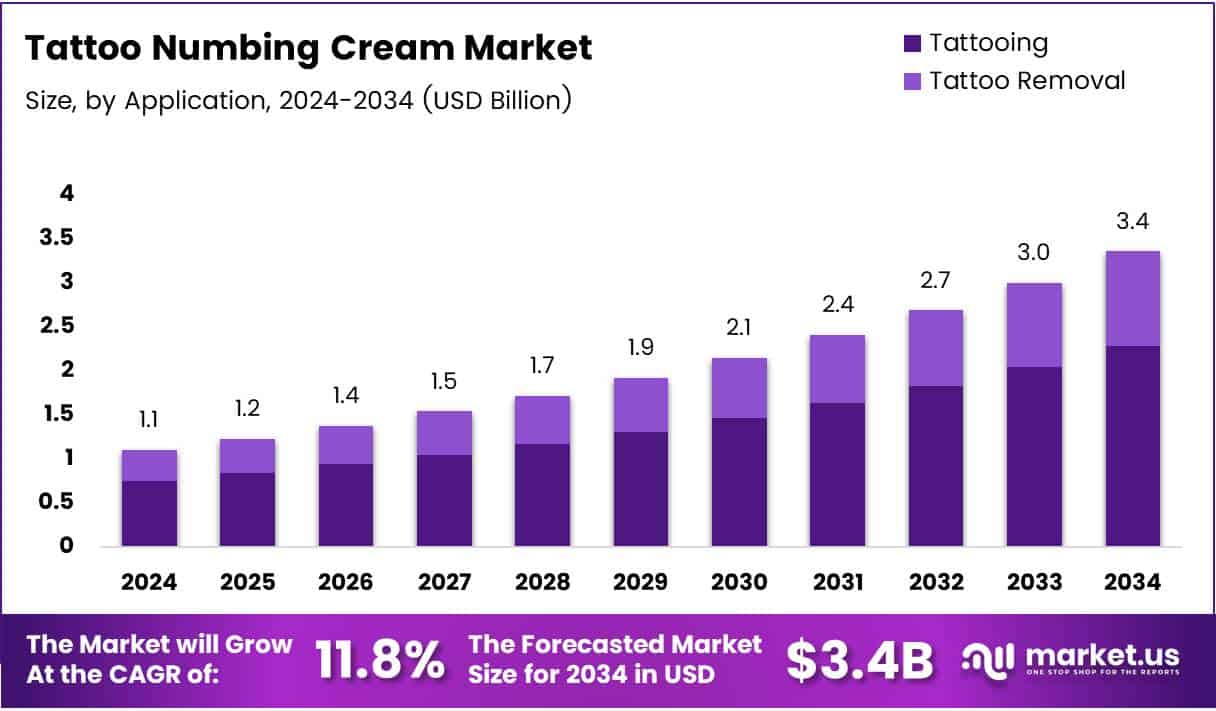The global tattoo numbing cream market is set to experience remarkable growth, with projections indicating a rise from USD 1.1 billion in 2024 to approximately USD 3.4 billion by 2034. This represents a compound annual growth rate (CAGR) of 11.8% during the forecast period from 2025 to 2034. The growth trajectory is driven by multiple factors, including the increasing popularity of tattoos across diverse demographics, the growing acceptance of tattoos as a form of self-expression, and the rising demand for effective pain relief during tattooing procedures.

Table of Contents
Market Dynamics and Growth Drivers
Tattoos have become a mainstream form of personal expression, with more individuals across the globe embracing body art. As tattoos continue to gain cultural acceptance, consumers are increasingly seeking ways to reduce the discomfort associated with the process. Tattoo numbing creams provide a solution by numbing the skin, allowing for a more comfortable tattooing experience. The growing popularity of tattoo numbing products is fueled by advancements in topical anesthetics, which ensure safety, efficacy, and minimal side effects.
The tattoo industry has witnessed a shift towards higher-quality products and services, which directly benefits the numbing cream market. Artists and consumers alike are becoming more aware of the importance of comfort during the tattoo process, leading to a rise in the adoption of numbing creams. Additionally, a growing number of consumers are opting for larger or more detailed tattoos, which often require longer tattoo sessions and can lead to greater discomfort, further driving the demand for pain management solutions.
Market Segmentation Insights
By Application
The tattooing application segment holds the largest market share, accounting for approximately 70.5% of the market in 2024. This dominance is attributed to the widespread use of numbing creams during tattoo procedures, which are commonly used by both amateur and professional tattoo artists to alleviate pain and discomfort for clients. The use of these creams is particularly essential for individuals opting for tattoos in more sensitive areas of the body.
By End User
In 2024, women accounted for 61.8% of the tattoo numbing cream market share. This figure highlights the growing interest among women in tattoos as a form of self-expression. As the tattoo industry becomes increasingly inclusive, more women are seeking pain relief solutions to make their tattoo experiences more comfortable. Additionally, the availability of numbing creams formulated specifically for sensitive skin types has further contributed to this growth.
By Distribution Channel
Offline channels dominated the market in 2024, capturing 70.6% of the market share. Tattoo parlors and physical retail stores remain the primary points of sale for numbing creams, as they offer customers the convenience of consulting with tattoo artists and experts who can recommend the best products for their needs. This face-to-face interaction and immediate availability continue to drive the dominance of offline sales channels.
Regional Outlook
North America is expected to lead the global tattoo numbing cream market during the forecast period. The region has seen a significant rise in tattoo acceptance and a growing number of tattoo parlors, which contributes to the increasing demand for numbing creams.
Take advantage of our unbeatable offer - buy now!

In the United States, tattoos are considered a significant form of personal expression, with millions of individuals regularly visiting tattoo parlors. As the tattoo industry in North America continues to expand, the demand for tattoo numbing creams is expected to grow exponentially.
Europe and the Asia-Pacific regions are also expected to see substantial market growth. In Europe, changing cultural perceptions and the influence of celebrity-driven tattoo trends have led to a greater acceptance of tattoos, especially among younger generations. Similarly, the Asia-Pacific region is experiencing an increase in disposable income and an evolving tattoo culture, further driving the adoption of numbing creams.
Competitive Landscape
The tattoo numbing cream market is highly competitive, with a range of players offering products designed to meet the growing demand for effective pain management during tattooing. The competition is driven by the need for innovation, with manufacturers focusing on improving the efficacy, safety, and comfort of numbing creams.
Strategic partnerships between tattoo artists, parlors, and numbing cream manufacturers are also becoming more prevalent, enabling both parties to offer enhanced experiences for customers. Leading companies are investing in research and development to formulate numbing creams that cater to different skin types and address specific customer needs.
Conclusion
The tattoo numbing cream market is set for substantial growth over the next decade, driven by factors such as the increasing acceptance of tattoos, growing consumer demand for pain relief during tattoo procedures, and the expanding global tattoo culture. As the market evolves, manufacturers are likely to focus on product innovation and enhanced customer experiences to capture a larger share of this rapidly expanding market. With North America leading the way and Europe and Asia-Pacific following closely behind, the future of the tattoo numbing cream market looks exceptionally promising.
Discuss your needs with our analyst
Please share your requirements with more details so our analyst can check if they can solve your problem(s)



